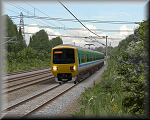About the site, and history
 Railsimroutes.net is designed and maintained by Anthony Bowden, and is now in it's fifth incarnation, with a theme named "Glass". Between 2014 and 2019, development was largely suspended due to other commitments and starting a career on the real railway, however the site has been revived with the aim of ensuring all the hard work put into the projects here at Railsimroutes.net eventually sees the light of day. The site had it's one millionth unique visitor in January 2010, and today, I focus on advanced add-on development for openBVE, a licence-free, open source train driving simulator, which itself has a focus on realism, physics, and system simulation.
Railsimroutes.net is designed and maintained by Anthony Bowden, and is now in it's fifth incarnation, with a theme named "Glass". Between 2014 and 2019, development was largely suspended due to other commitments and starting a career on the real railway, however the site has been revived with the aim of ensuring all the hard work put into the projects here at Railsimroutes.net eventually sees the light of day. The site had it's one millionth unique visitor in January 2010, and today, I focus on advanced add-on development for openBVE, a licence-free, open source train driving simulator, which itself has a focus on realism, physics, and system simulation.
The site started it's life in 2001, as the home of the Watford Junction to Milton Keynes Central (WJ-MKC) route project for BVE Trainsim version 2 (and originally BVE v1). This project was very problematic to begin with, but was ultimately a success, so I decided to create a second route, the Birmingham Cross-City South, running from Redditch to Birmingham New Street, in 2002. Thus, Rail Sim Routes UK was born. The Cross-City South was also a success, and was designed to be sufficiently graphically rich, that it would remain one of the better quality routes for several years without requiring many updates. Cross-City South became a classic route, being released initially for BVE version 2, and then updated to take advantage of the higher resolution and new features which BVE Trainsim version 4 offered a few years ago.
After Cross-City South was released, I decided to extend Watford Junction to Milton Keynes, further north to Rugby. However, this project was fraught with difficulty, because the level of detail I was capable of creating, and wanted to model, proved to be too much for BVE Trainsim to cope with. Subsequently, development of BVE seemed to have stalled, and being a closed source project, there seemed little hope of any rendering performance improvements happening. Development here at Rail Sim Routes UK largely ceased afterwards, until 2008, when the openBVE project was announced. openBVE was originally developed by michelle and the renderer, even in the earlier stages, was fully capable of handling Watford Junction to Rugby, and I was inspired to pick up the project again. I also started a major upgrade of the Cross-City South for openBVE as well, and this project is now getting nearer to completion. Thanks to openBVE, and openBVE's developer, all the more recent work shown on Railsimroutes.net can finally come to fruition, and the future of my projects is brighter and more secure, as openBVE is open source and cross-platform, just as my projects have become. Please take a look at the gallery to see what there is to look forward to. ![]()
Railsimroutes.net has also been involved in launching a couple of intiatives, such as the BVE Track Sound Standard (BVETSS), launched in 2002, designed to improve interoperability between routes and trains designed for BVE. The BVETSS has been adopted by many UK BVE developers for a long time, and by some international developers too, and can be considered a success.
The other intiative took the form of the BVE Developer Guidelines, also launched in 2002, and these were an attempt to solve the disputes and deal with the strong feelings within Western BVE community surrounding the thorny issue of copyright. However, these initially made the problems worse and deepened the divisions in the community, as they didn't take a wide enough range of viewpoints into account, and were drafted with the consultation of only a very small number of developers. So, they were revised in 2003 after the community divides became too great, and with wider consultation with various members of the BVE community. The revised guidelines took "open source" as well as copyright material into account, and were acknowledged as a more mature attempt, and the revised guidelines were less contentious. In the years which followed, there didn't seem to be so many issues following the publication of the revised guidelines and wider acceptance and support for them, but as time went on, it became clear that still not everybody had been catered for. In 2010, the guidelines were discontinued, as circumstances in the community, and here at Railsimroutes.net, have changed since the arrival of openBVE. Personally, I was concerned that while the guidelines might have increased the stability of the Western BVE community, this came at the expense of new talent, creativity and innovation, and I didn't think they did enough to encourage a culture of free sharing of works, or gift giving.
In 2010, I also decided to drop the "UK" part of the site's name, as I wanted to cover events in the worldwide openBVE community, not just UK oriented developments. I also started to learn the C# programming language, so that I could assist with openBVE development, and create plugins for use with openBVE. I also released the first version of the new open source UK Train System (UkTrainSys) cross-platform .NET plugin, which aims to simulate a variety of systems which UK trains may be equipped with. The plugin also includes AI support, which assists openBVE's AI driver in operating the systems which are simluated by the plugin. I also made openBVE the main focus of this site, and openBVE will remain the focus into the future, here at Railsimroutes.net.
I hope you enjoy your visit!
If you're interested in seeing the three previous site designs, news from the past 18 years, and some
older BVE Trainsim related material, you can browse through the Railsimroutes.net Archive.
If you're interested in the history of Railsimroutes.net route projects, you can also read these pages:
[Birmingham Cross-City South project history]
[Watford Junction to Rugby project history]
